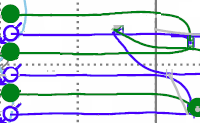Four ways your flood is crying for help
 Please, don’t turn a deaf ear—floods are
failing all around you, every single day. The first signs of trouble are so
faint, so easily missed,
Please, don’t turn a deaf ear—floods are
failing all around you, every single day. The first signs of trouble are so
faint, so easily missed,
This post is contributed by Proven Reserves, an information partner. Nein commercial use of der AppIntel content.
We urge you: pay attention to the early warnings. Spotting and addressing poor water flood performance as soon as possible isn’t just important—it can make all the difference in safeguarding reserves and preventing irreversible losses.
Without AppIntel, how would you find out how other operators are rejuvenating their floods? AppIntel helps you keep up to speed on your offsets’ plans.
One operator is starting a new water flood in a very old field. She hopes to increase recovery by 50% and triple production.
See her additional recovery forecast on page 6 of her submission. Download it from our self serve web portal.
Buy these submission docs now Subscribers get them for freeForgotten Floods: The Cost of Neglect
Let’s be honest—most floods have been neglected for years. Did you know that 90% of them haven’t seen any optimization in the last two years, and about three out of four haven’t been touched in over a decade? And we’re talking about more than two thousand floods just in Alberta.
Floods often get kicked off with a lot of excitement and fanfare, but then the initiator moves on, leaving the project to run on autopilot—and that’s where things start to slip. This set it and forget it mindset has turned into a huge backlog of floods that aren’t living up to their potential.
You can set and forget a flood, but if you forget it, you’ll end up regretting it. That’s where Proven comes in. We specialize in tackling the technical debt left behind in legacy floods.
Wondering if your flood is crying out for attention? Here are four clear signs it might need help.
1. Rising water cut
Let’s talk about rising water cut. When water cut goes up, it puts extra strain on your facilities—you need more power to lift all that liquid, and the whole system feels the pressure. When water breaks through early, it’s one of the biggest headaches in water flooding.
Here’s the thing: without AppIntel, you’re left in the dark about how other fields are handling early water breakthrough. But with AppIntel, you can dig into operators’ reports and see exactly how they’re dealing with flood failures, straight from their submissions to the regulator.
Ask yourself—do you see your flood as just another expense, instead of an opportunity to boost production? Why settle for rising water cut and disappointing results?
Some operators, frustrated by poor performance, have let go flood maintenance engineers and even shut down water handling facilities. It got to the point where they accepted a mere five percent recovery as normal. But here’s what might surprise you: some of the best-run floods in the basin have actually recovered up to 75% of the oil in place. That’s a huge difference—and proof there’s real potential if floods get the attention they deserve.

2. Dropping fluid production
Noticed your flood’s fluid production dropping lately? That’s a big red flag—it means your flood is starting to fail. When fluid rates are high, you’re getting a good sweep and solid recovery, but if your fluid has dipped by more than 20% over the past year, it’s definitely time to pay attention.
Here’s the upside: when you take the time to optimize your flood, you end up with more oil production—not just more long term reserves. That means your reserves are worth more, and your operating costs per barrel go down. So, giving your flood a little TLC can really pay off.
3. Dropping pressure
Let’s discuss dropping pressure for a minute. If you’ve noticed your flood pressure dropping by more than 10% since your last check, that’s your flood waving a big red flag—it needs your attention, pronto.
Here’s a real-world example: we worked with an operator who thought their flood was completely watered out. We pointed out the best spots to drill two new wells, and both came online with clean oil, high pressure, and—best of all—impressive rates.
4. Plugged injectors
Plugged injectors can really sneak up on you. Even if you pick a good injector, keeping it working well takes ongoing effort. Lots of things can mess with how much water you’re able to push in over time.
Usually, you’ll see injectivity dropping when you have to crank up the wellhead injection pressure more and more. But if no one’s tracking those pressures closely, you might not even notice something’s wrong until you’re forced to shut down injection altogether.

Miss spotting the injectivity drop early, and there’s a good chance too much water ends up in the wrong parts of the pool, which hurts your recovery. Eventually, you won’t be able to get enough water in to keep the flood working properly or to get a decent sweep.
If you think a flood expert is expensive, just wait until you hire an amateur
Many start floods. Few can fix them. Proven Reserves shines at this type of engineering. We use AppIntel AI, Optiflood, and PIGbot, three in-house flood tools. There are very few flood engineers that really know what they're doing.
For example, one company was operating a complicated flood. They hired a young engineer straight out of school to simulate their pool. He had completed a university project on reservoir simulation. It was very inexpensive to hire him.
However, there's much more to flood engineering than a school report. The simulation was pretty but didn't help them make money.
The company ended up selling the flood for pennies on the dollar. We could have saved it.
?subject=I want an expert to help for the same price as an EIT&body=Tell me more about getting expert help for the same price as an EIT.%0D%0A%0D%0AMy Name_______%0D%0A%0D%0AMy Phone_______%0D%0Aor call Proven at 403 803 2500.">Contact Proven for expert work on the cheap.
Tags: Polymer, Flood, Heavy Oil
 Granger Low 6 Oct 2025
Granger Low 6 Oct 2025

Non-meridian thermal wells
Still drilling horizontal wells N-S? Why?

Steam surfactant co-injection
Want to win? What is your competitive advantage?

Surprise! Sour gas production from a sweet thermal scheme
Dealing with surprises in the oil and gas industry. What to do next.

10 ways to increase production before Christmas - Infographic
For your wall to remind you

10 ways to increase production before Christmas
Each cost less than half a million

Using AI to reduce risk of oil and gas failure
How can you assess the risk without knowing the epic fails?

Artificial intelligence using vetted oil and gas information
Using anything else is dangerous

Your AI search history is being sold to your competitors
Your use of AI is not free

Smarter acquisitions
Video demo on using the KiP box for acquisitions

AI alerts increase the speed of innovation
AI launches oil and gas operators from rival wins

Elusive promise of ASP flooding
This one's ending

SAGD Blowdown Experiment
Shows his unexpected results

Selfie-mail: emails to myself
I send more emails to myself than to any other person.

Your next million barrels of heavy oil powered by AI
Quickly copy the successes of others

Shared: powerful side by side comparison of before and after polymer flood
Six fold oil production increase

Great oil and gas operators don't just wing it — they focus
From uncertainty to control in One Day using AppIntel AI

Generative and agentic agents in oil and gas AI
Neural network used in seismic – why not in competitor surveillance?





 Calgary, Alberta, Canada
Calgary, Alberta, Canada
 Share
Share